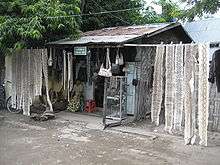Snakeskin
Snakeskin may either refer to the shed skin of a living snake after moulting or to a type of leather that is made from the hide of a dead snake.
Shed skin
The moulting of the skin occurs regularly, when old skin is outgrown. In the case of snakes, it is called shedding or ecdysis. Snakes will rub against rough surfaces to shed their skin. A shed skin is much longer than the snake that shed it, as the skin covers the top and bottom of each scale. If the skin is shed intact, each scale is unwrapped on the top and bottom side of the scale which almost doubles the length of the shed skin. While a snake is in the process of shedding the skin over its eye may become milky. This impairs the vision of the snake and as a result most snakes will become more aggressive because the snake feels more vulnerable.
Leather
Snakeskin is used to make clothing such as vests, belts, boots or shoes or fashion accessories such as handbags and is used to cover the sound board of some string musical instruments, such as the banhu, sanxian or the sanshin.
Snake leather is regarded as an exotic product alongside crocodile, lizard, ostrich, emu, camel, among others. With crocodile and lizard leathers, it belongs to the category of reptile leathers, with a scaly appearance.
Images
 Chinese sanxian with snakeskin-covered sound board
Chinese sanxian with snakeskin-covered sound board Snakeskin boots in Arizona
Snakeskin boots in Arizona Leather goods and skins of Burmese python (Python molurus bivittatus) and reticulated python (Python reticulatus reticulatus) at a local shop at Mandalay, Burma
Leather goods and skins of Burmese python (Python molurus bivittatus) and reticulated python (Python reticulatus reticulatus) at a local shop at Mandalay, Burma Snakeskin artifact
Snakeskin artifact.jpg) A vintage clutch with a fold-over closure, made of red snakeskin
A vintage clutch with a fold-over closure, made of red snakeskin.jpg) The Lamia: In this 1909 painting by Herbert James Draper, Lamia has human legs and a snakeskin around her waist. There is also a small snake on her right forearm.
The Lamia: In this 1909 painting by Herbert James Draper, Lamia has human legs and a snakeskin around her waist. There is also a small snake on her right forearm.- A shed snake skin in nature
See also
| Wikimedia Commons has media related to Snake skins. |